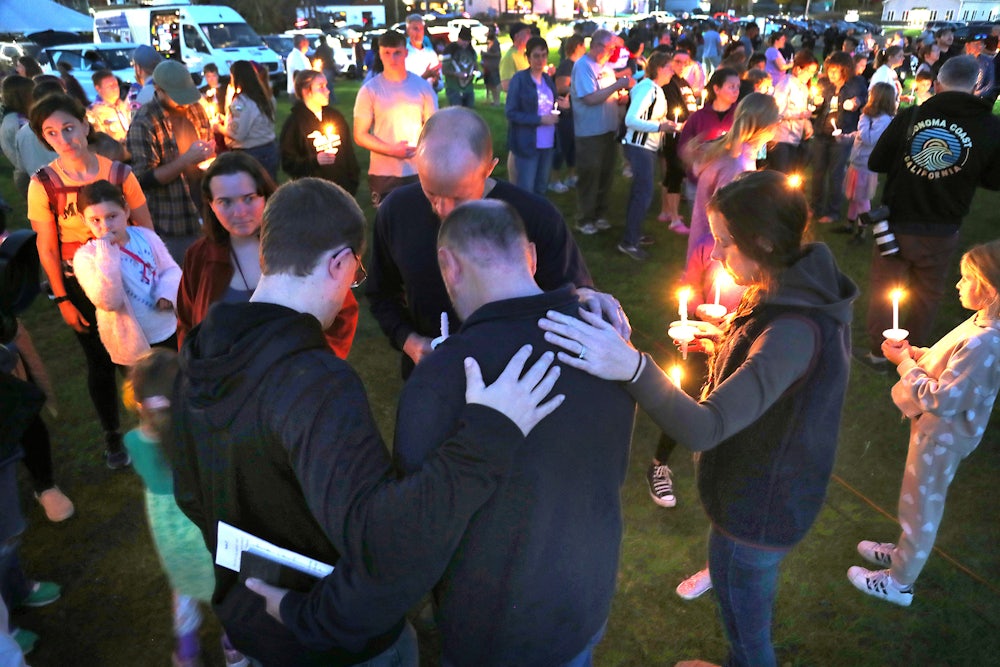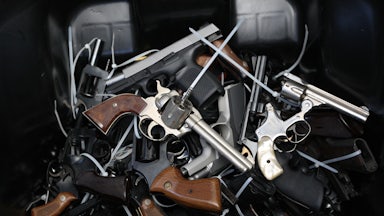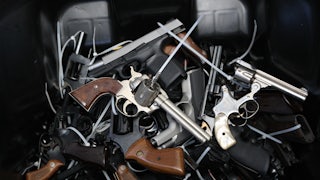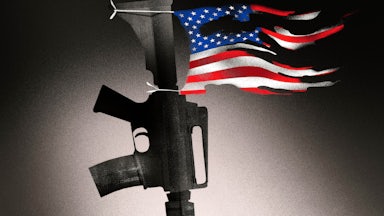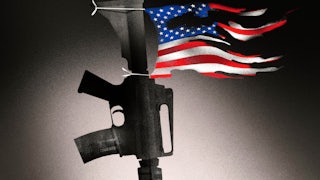This story was published in partnership with The Trace, a nonprofit newsroom covering gun violence in America. Sign up for its newsletters here.
The perpetrator of the October 25 shooting in Lewiston, Maine, who killed 18 people and wounded 13 others, was admitted to a psychiatric facility in New York state for two weeks this past summer. He was still able to legally buy guns afterward, officials have said.
It’s unclear whether his stay at the facility was voluntary or involuntary—a key distinction that determines whether he could legally possess firearms. If the Lewiston shooter’s admission had been an involuntary emergency hospitalization, as some reports suggest, his information would have been automatically transmitted to the National Instant Criminal Background Check System, or NICS, barring him from purchasing guns nationwide. If he was voluntarily admitted, as other reports indicate he may have been, his stay wouldn’t have prohibited him from owning firearms.
Regardless, the case has raised questions about what kinds of mental health hospitalizations disqualify someone from buying or owning firearms—and how so many mass shooters retain their gun rights even after interactions with mental health systems.
The Trace conducted a comprehensive analysis of gun laws in all 50 states and found that only five states—California, Connecticut, Hawaii, New York, and Washington—impose some form of a gun ban after an emergency mental health hospitalization that’s not followed by a court-ordered commitment.
Over the past 20 years, at least 13 high-profile shootings were carried out by perpetrators who were able to legally buy guns after being released from an emergency hospitalization, according to our analysis. These shootings collectively killed 86 people and wounded 70 others. They include the Buffalo, New York, supermarket shooting (2022), the Indianapolis FedEx shooting (2021), the Fifth Third Center shooting in Cincinnati (2018), the Fort Lauderdale Airport shooting (2017), the Umpqua Community College shooting in Roseburg, Oregon (2015), the Virginia Tech shooting (2007), and the Goleta post office shooting in Santa Barbara, California (2006).
[To view the data visualization more closely, click here.]
Ian Ayres, a Yale Law School professor who co-authored a 2020 study on mental health–related gun prohibitions, told The Trace that people released from an emergency mental health hospitalization have been assessed at some point to be a danger to themselves or others, even if a judge did not commit them to a psychiatric facility. “So it’s a natural group to consider whether we’re taking the appropriate steps to decide whether to disarm them or not,” he said.
The danger is especially acute when someone is at risk of self-harm, Ayres said, as was the case with several of the shooters we identified. “When people become suicidal, a small proportion of them choose to kill other people in the process,” he said. According to the Gun Violence Archive, a nonprofit that tracks shootings through news and police reports, there have been 610 murder-suicides so far this year.
Concerns over the limits of mental health–related gun bans cropped up earlier this month, after a man shot and wounded four people at a Walmart in Beavercreek, Ohio. Authorities said he had been detained for an emergency mental health hospitalization twice in 2022.
The Lewiston and Beavercreek incidents highlight two critical distinctions in the law—between voluntary and involuntary commitment, and between an emergency hospitalization and longer-term, court-ordered treatment.
The Trace’s analysis found that the vast majority of states and Washington, D.C., follow federal law, meaning only an involuntary, court-ordered commitment to a mental health facility triggers a gun ban. Some states go a little further, restricting guns for people who are ordered by a court to undergo mental health treatment in an outpatient facility. A handful of states ban guns for people who are voluntarily committed. Only a few ban guns for emergency hospitalizations that aren’t followed by a court-ordered commitment.
Most mass shooters are not formally diagnosed with mental illness prior to their attacks, so emergency hospitalizations are often their only contact with mental health care providers or law enforcement. Police or medical professionals can detain someone in the throes of a mental health crisis for some form of an emergency hospitalization—a short-term, involuntary stay that allows them to undergo an evaluation.
But at some point—a duration that varies from hours to weeks depending on the state—a court hearing is required to detain them longer. A judge must decide whether they pose a danger to themselves or others to merit an involuntary commitment. If a judge orders their commitment, they are then subject to an indefinite gun ban under federal law. However, in most of the country, a patient who is released after an emergency hospitalization retains their right to own firearms.
Gun rights advocates frequently oppose gun bans for emergency hospitalizations, arguing that they unjustly deprive people of their constitutional right to own firearms. In 2016, the Hawaii Legislature moved to impose a temporary gun ban on people admitted for a 48-hour emergency hospitalization. The state’s chapter of the National Rifle Association made an ultimately unsuccessful attempt to stop the bill, despite the fact that the lawmakers who envisioned it created a path for people to regain their gun rights after their mental health crisis subsides.
It is not just gun rights advocates who have concerns about these types of bans. In November, Emmy Betz, an emergency medicine professor who directs the Firearm Injury Prevention Initiative at the University of Colorado School of Medicine, co-authored a survey of each state’s process for reporting mental health records to NICS. She said she worries that if a short-term mental health hospitalization automatically results in a firearms prohibition, it might discourage people from seeking help, especially if they fear losing the guns they already own.
“How do we find that balance between individual rights and responsibilities and community safety? I think that’s the question that we as a society are grappling with,” Betz said. “These are hard conversations for us to have, but we have to keep having them.”
In The Trace’s analysis, California, Connecticut, Hawaii, New York, and Washington all limit guns for people who have been subject to an emergency hospitalization. But the laws vary widely from state to state, and it’s difficult to assess whether they prevent shootings. There are no statistics on how often these laws are implemented or how many prospective gun purchasers fail a background check for that reason.
Ayres, the Yale professor, said the laws are probably not being implemented as often as they could because health care providers may be unaware that they exist. For his study, Ayres and his team surveyed 485 psychiatrists in nine states and Washington, D.C. They found that, in the states that ban guns for emergency hospitalizations, more than half of the doctors—56 percent—didn’t know about it.
In New York, where the Lewiston gunman was treated, a firearm prohibition takes effect when a person is formally admitted to a hospital by mental health care providers; that prohibition is indefinite. New York’s law requires the state Office of Mental Health to report any emergency mental health admissions to the state’s database of prohibited purchasers, which forwards the information to NICS. The Lewiston gunman’s 14-day stay in a psychiatric facility doesn’t appear to have been reported to NICS. Authorities haven’t yet explained why.
California allows law enforcement or health workers to temporarily remove guns from a patient once they’re detained for emergency evaluation. Should the person be formally admitted for inpatient hospitalization, they are subject to a five-year gun ban.
But Amy Barnhorst, associate director of the Violence Prevention Research Program at the University of California, Davis, said that as many as half of all patients are never formally admitted because hospitals don’t have enough beds to take them. In those cases, the patients are exempted from the gun ban and can get any seized guns returned to them.
If police in California want to seize guns from a patient’s home during an emergency hospitalization, they must either get a warrant or invoke the state’s red flag law, which allows law enforcement, family members, and other close contacts to petition a judge for an order to temporarily seize guns from someone in crisis.
Margaret Groban, a former federal prosecutor who teaches about the Second Amendment and firearm regulation at the University of Maine School of Law, said the involvement of a judge makes red flag laws less likely to provoke concerns about violating a person’s constitutional rights. Laws that ban guns after emergency hospitalizations “are looking exclusively at mental health. Red flag laws are looking at the combination of a crisis and firearms,” Groban said. “And so that should be the avenue for relinquishment of firearms.”
Twenty-one states have a red flag law, and some allow mental health providers to file petitions. Eighteen of those states don’t implement a gun ban with an emergency hospitalization. So only a third of the country currently has some mechanism to disarm a person who poses a potential danger to themselves or others.
Additionally, unlike a red flag order, involuntary commitment gun bans can easily be subverted, said Groban, who also sits on the board of the Maine Gun Safety Coalition, a gun violence prevention group based in Portland. When an emergency hospitalization is ending, and a mental health provider is deciding whether a long-term commitment is appropriate, the patient is informed of their options. In most states, consenting to treatment instead of being ordered into it by a judge exempts patients from a gun ban—because federal law doesn’t ban guns for people who have been voluntarily committed.
Red flag laws have emerged precisely because of these workarounds, Groban said. Indiana’s red flag law was named for a police officer, Jake Laird, who was shot and killed in 2004 by someone who’d been released after an emergency mental health evaluation and subsequently demanded the return of his guns.
Maine, where the Lewiston shooter lived, doesn’t have an emergency hold gun ban or a red flag law. In 2020, the state enacted a “yellow flag law,” which is a combination of both policies that has added up to less than the sum of its parts. Unlike a red flag law, Maine’s yellow flag law requires that a person be taken into police custody and then assessed by a mental health professional before a judge decides whether to remove their guns, a provision that was added as a concession to gun rights advocates. Police in Maine say they’ve had a hard time tracking down doctors to conduct those assessments—delaying a process that’s supposed to be urgent.
Groban called Maine’s yellow flag law “woefully inadequate” and said it squandered valuable mental health resources in a system that’s already stretched. “No one can get in to see a counselor, but we’re using resources to make an assessment that judges make every day of the week,” she said.
Maine’s yellow flag law has been used more than 100 times since it took effect in 2020. At least 36 of those cases were initiated after the Lewison shooting in October, suggesting that the shooting—the state’s deadliest—has raised awareness of the policy.
It’s unclear why police in Maine didn’t initiate the yellow flag process before the Lewiston gunman struck. Police in Saco were aware that he’d leveled threats against his Army Reserve unit in upstate New York, and it was his unit commanders who sent him for that psychiatric evaluation in July. His family reached out to police in Sagadahoc County, where he lived, and reported his erratic behavior in May, but authorities didn’t initiate a yellow flag petition.
“That’s the tragedy of this,” Michael Carpenter, a former state senator, told Maine Public Radio. “The law is only going to work if the people do what they’re supposed to do.”
